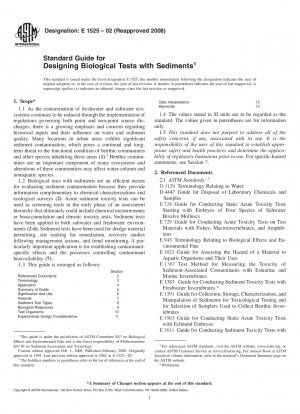ASTM E1525-02(2008)
Standard Guide for Designing Biological Tests with Sediments
- Standard No.
- ASTM E1525-02(2008)
- Release Date
- 2002
- Published By
- American Society for Testing and Materials (ASTM)
- Status
- Replace By
- ASTM E1525-02(2014)
- Latest
- ASTM E1525-02(2023)
- Scope
Contaminated sediments may affect natural populations of aquatic organisms adversely. Sediment-dwelling organisms may be exposed directly to contaminants by the ingestion of sediments and by the uptake of sediment-associated contaminants from interstitial and overlying water. Contaminated sediments may affect water column species directly by serving as a source of contaminants to overlying waters or a sink for contaminants from overlying waters. Organisms may also be affected when contaminated sediments are suspended in the water column by natural or human activities. Water column species and nonaquatic species may also be affected indirectly by contaminated sediments by the transfer of contaminants through ecosystems (7, 8).
The procedures described in this guide may be used and adapted for incorporation in basic and applied research to determine the ecological effects of contaminated sediments. These same methods may also be used in the development and implementation of monitoring and regulatory programs designed to prevent and manage sediment contamination.
Sediment tests with aquatic organisms can be used to quantify the acute and chronic toxicity and the bioavailability of new and presently used materials. Sediment toxicity may also result from environmental processes such as ammonia generation, pH shifts, or dissolved oxygen fluctuation. In many cases, consideration of the adverse effects of sediment-associated contaminants is only one part of a complete hazard assessment of manufactured compounds that are applied directly to the environment (for example, pesticides) and those released (for example, through wastewater effluents) as by-products from the manufacturing process or from municipalities (7).
Sediment tests can be used to develop exposure-response relationships for individual toxicants by spiking clean sediments with varying concentrations of a test chemical and determining the concentration that elicits the target response in the test organism (Guide E 1391
). Sediment tests can also be designed to determine the effects that the physical and chemical properties of sediments have on the bioavailability and toxicity of compounds. Sediment tests can provide valuable information for making decisions regarding the management of contaminated sediments from hazardous waste sites and other contaminated areas. Biological tests with sediments can also be used to make defensible management decisions on the dredging and disposal of potentially contaminated sediments from rivers and harbors. ((7, 8), Test Method E 1706.)
1.1 As the contamination of freshwater and saltwater ecosystems continues to be reduced through the implementation of regulations governing both point and non-point source discharges, there is a growing emphasis and concern regarding historical inputs and their influence on water and sediment quality. Many locations in urban areas exhibit significant sediment contamination, which poses a continual and long-term threat to the functional condition of benthic communities and other species inhabiting these areas (1). Benthic communities are an important component of many ecosystems and alterations of these communities may affect water-column and nonaquatic species.
1.2 Biological tests with sediments are an efficient means for evaluating sediment contamination because they provide information complementary to chemical characterizations and ecological surveys (2). Acute sediment toxicity tests can be used as screening tools in the early phase of an assessment hierarchy that ultimately could include chemical measurements or bioaccumulation and chronic toxicity tests. Sediment tests have been applied in both saltwater and freshwater environments
ASTM E1525-02(2008) Referenced Document
- ASTM D1129 Standard Terminology Relating to Water
- ASTM D4447 Standard Guide for Disposal of Laboratory Chemicals and Samples
- ASTM E1023 Standard Guide for Assessing the Hazard of a Material to Aquatic Organisms and Their Uses
- ASTM E1367 Standard Guide for Conducting 10-day Static Sediment Toxicity Tests with Marine and Estuarine Amphipods
- ASTM E1383
- ASTM E1391 Standard Guide for Collection, Storage, Characterization, and Manipulation of Sediments for Toxicological Testing
- ASTM E1563 Standard Guide for Conducting Static Acute Toxicity Tests with Echinoid Embryos
- ASTM E1611 Standard Guide for Conducting Sediment Toxicity Tests with Polychaetous Annelids
- ASTM E1676 Standard Guide for Conducting Laboratory Soil Toxicity or Bioaccumulation Tests With the Lumbricid Earthworm Eisenia Fetida
- ASTM E1688 Standard Guide for Determination of the Bioaccumulation of Sediment-Associated Contaminants by Benthic Invertebrates
- ASTM E1706 Standard Test Method for Measuring the Toxicity of Sediment-Associated Contaminants with Freshwater Invertebrates
- ASTM E724 Standard Guide for
Conducting Static Acute Toxicity Tests Starting with Embryos of Four Species of Saltwater Bivalve Molluscs - ASTM E729 Standard Guide for Conducting Acute Toxicity Tests on Test Materials with Fishes, Macroinvertebrates, and Amphibians
- ASTM E943 Standard Terminology Relating to Biological Effects and Environmental Fate
- IEEE/ASTM SI 10 American National Standard for Metric Practice
ASTM E1525-02(2008) history
- 2023 ASTM E1525-02(2023) Standard Guide for Designing Biological Tests with Sediments
- 2002 ASTM E1525-02(2014) Standard Guide for Designing Biological Tests with Sediments
- 2002 ASTM E1525-02(2008) Standard Guide for Designing Biological Tests with Sediments
- 2002 ASTM E1525-02 Standard Guide for Designing Biological Tests with Sediments
- 1994 ASTM E1525-94a Standard Guide for Designing Biological Tests with Sediments
- 1994 ASTM E1525-94 Standard Guide for Designing Biological Tests with Sediments
